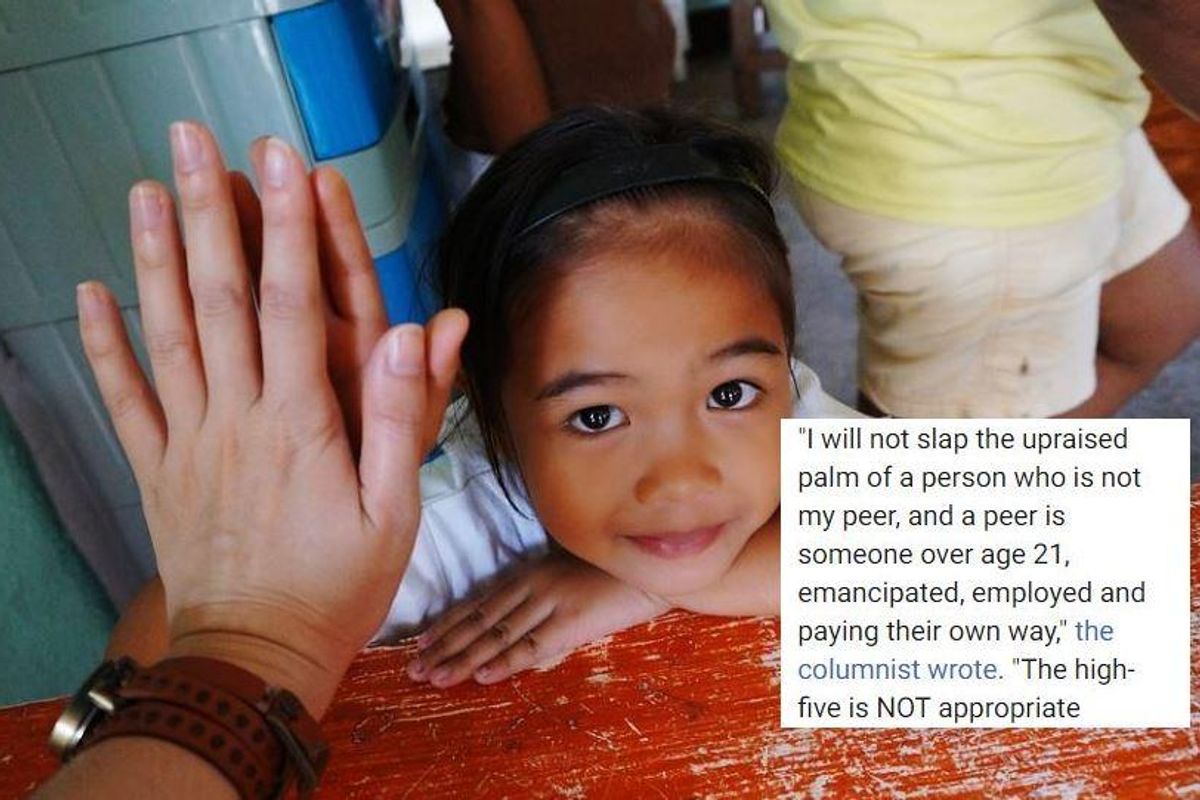A viral editorial saying adults shouldn't high-five children has parents sounding off
Does he have a point?

Giving a high-five to a kid who needs one.
John Rosemond, a 74-year-old columnist and family psychologist, has folks up in arms after he wrote a column about why he never gives children high-fives. The article, “Living With Children: You shouldn't high-five a child” was published on the Omaha World-Herald’s website on October 2.
The post reads like a verse from the “Get Off My Lawn” bible and posits that one should only share a high-five with someone who is one's equal.
"I will not slap the upraised palm of a person who is not my peer, and a peer is someone over age 21, emancipated, employed and paying their own way," the columnist wrote. "The high-five is NOT appropriate between doctor and patient, judge and defendant, POTUS and a person not old enough to vote (POTUS and anyone, for that matter), employer and employee, parent and child, grandparent and grandchild."
Does he ask to see a paystub before he high-fives adults?
“Respect for adults is important to a child’s character development, and the high-five is not compatible with respect,” he continues. “It is to be reserved for individuals of equal, or fairly equal, status.”
Rosemond believes that a child should “know their place” and that once they high-five an adult they have no reason to obey them.
Anecdotally, I’ve found that sharing a high-five with a kid has nothing to do with whether they will obey me or not. I coach AYSO soccer and give out high-fives till I’m bruised on game day and come next practice they are all great listeners.
The article got a big reaction on Twitter after it was shared by a user named erin, Ph.D.
\u201cWhat\u201d— erin, Ph.D (@erin, Ph.D) 1664802076
A lot of people had no trouble challenging Rosemond's logic.
I offered a high-five to a kid on Saturday at a party because he joined us on the dance floor and cut a rug. He rejected my high-five. Apparently, he didn’t see me as his equal? 🤔
— lisa (@gfxchick) October 3, 2022
Among my many questions for John is why the heck he holds the high-five in such high regard?
— Rob Hill (@robhill5) October 3, 2022
This is like so much time spent on an action that just seems like whatever. I have never given this much thought to a high five, or ever thought kids were less important than me .
— Kris Kinzie (@KinzieKris) October 3, 2022
"Children should feel small and insignificant" is not the way I would go.
— More Housing Choices; NH=neighborhood (@bnjd1837) October 3, 2022
Others took the opportunity to crack some jokes.
Dude got hit with the 'down low too slow' and now he's pissed
— nORMAL bRANDON (@higgs_bozo) October 3, 2022
The fact that we give children small, free gestures of affection is a sign that we are headed into a long, national nuclear winter
— Jane (@janetherevelatr) October 3, 2022
“Emancipated” tells you everything you need to know.
— The Jaw (@welivedhappily) October 3, 2022
The column made some realize they'd been ruining the nation's youth without knowing it.
I had not read this yet and I high fived 2 small children on the walk to school this morning. Aren’t I a menace.
— Emily (@theothermoody) October 3, 2022
Pediatric ER RN for 30 years and I flabbergasted that I ruined so many kids high-fiving them after blood draws and IV starts. I’m going to hell.
— Katy Perkins (@KatePOBrien) October 3, 2022
My 1.5 year old high fives us and I think it’s adorable, but I guess John has enlightened me that I’ve actually broken her. Dang it!
— Liz Lord (@mslizlord) October 3, 2022
30 years in public education as a teacher and administrator. I have easily high-fived more than a thousand children over the years, encouraging them with affirmations of "good morning" "have a great day" "well done" and "that's awesome" in the process . What a fool I've been.
— Rocky McDillweed-Chrysler 🌵 (@rockychrysler) October 3, 2022
Of course, this guy earned his "old man yells at cloud" award.
Never has a GIF more naturally come to my mind… pic.twitter.com/sCahQ6IMtj
— Jay Jackson 🇺🇸 (@jaycjackson) October 3, 2022
We have a winner.
I raised 5 respectful sons and this was never an issue. Kids already know you’re an adult if you’re doing your job.
— THEE Sigmundine (@Sigmundine2) October 3, 2022
To Rosemond’s credit, he begins the post with full knowledge of the criticism he’s going to receive. “I’m talking about adults high-fiving children, and yes, I am about to reveal that I am the Grinch, or so it would seem,” he wrote.
It’s pretty easy to pile on Rosemond for his antiquated views of how we should interact with children. It’s pretty clear that he has a conflated view of what a high-five between two people means. It’s a fun way to give someone simple praise, no more, no less.
It seems that Rosemond missed the mark on finding a way to get to a point that is correct about the parent-child relationship: “Boundaries in relationships are essential to their proper functioning,” he writes.
Then he lays out some commonsense parenting advice.
“Children should not call their parents (or any other adults) by their first names,” he writes. “They should not sleep with their parents. They should not have free access to their parents’ money (yes, I am saying children should not have credit cards). They should not be allowed to view certain movies their parents view.”
Rosemond writes that a high-five isn’t “compatible with respect.” But he should also know that refusing to dole out simple praise may not make one worthy of respect in the first place.
- The best parenting advice I've read in a long time. Someone will ... ›
- Mom-of-four shares the poignant parenting advice she received from ... ›
- 6-year-old students give hilarious parenting advice to pregnant ... ›
- The best parenting advice I've read in a long time: Someone will always criticize you. - Upworthy ›



 sipping modern family GIF
sipping modern family GIF  A woman dealing with burnout.via
A woman dealing with burnout.via  A woman dealing with burnout.via
A woman dealing with burnout.via  Grandparents say kid's behavior is getting worse. Photo by
Grandparents say kid's behavior is getting worse. Photo by  Despite the narratives, there are a lot of grandparents out there that have healthy, loving relationships with the grandkids. Photo by
Despite the narratives, there are a lot of grandparents out there that have healthy, loving relationships with the grandkids. Photo by  It's not an empty nest. It's an open door.
It's not an empty nest. It's an open door.